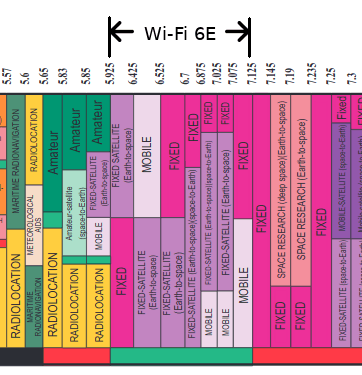If you live and/or work in an urban environment, you may have noticed 2.4GHz WiFi may not be so reliable as too many people are using the frequency leading to interference. 5 GHz WiFi is here to help, but with the Internet of Things more and more WiFi devices will come online in the next few years, and there won’t be enough capacity using 2.4 and 5 GHz. 60GHz WiFi (802.11ad/802.11ay) may not work for IoT since the signal would not go through walls.
That’s why the Wi-Fi Alliance has introduced WiFi 6E, and upgrade of WiFi 6, that can leverage 6 GHz unlicensed spectrum and expand the bandwidth available for Wi-Fi.
 I’ve taken the US spectrum wall chart from 2016 to show where WiFi 6E would stand, and it looks pretty crowded to me with mobile, fixed and satellite applications using the 5.925 to 7.125 GHz spectrum to be used by the new Wi-Fi standard.
I’ve taken the US spectrum wall chart from 2016 to show where WiFi 6E would stand, and it looks pretty crowded to me with mobile, fixed and satellite applications using the 5.925 to 7.125 GHz spectrum to be used by the new Wi-Fi standard.
Wi-Fi 6E may soon become available because of recent or future regulatory changes to the 6 GHz spectrum in various countries. In the US, the proposal to open the 5.925 – 7.125 GHz spectrum was made on October 23, 2018, but the final decision is still pending.
The Wi-Fi Alliance expects the 6 GHz spectrum to become available around the world, and supports international advocacy efforts to make this additional spectrum available to Wi-Fi users while protecting existing devices in the band. IDC mentions the US is taking the lead in enabling 6 GHz for WiFi, but Europe and APAC are also working on opening it up.
WiFI 6E will allow 14 additional 80 MHz channels and 7 additional 160 MHz channels for high-bandwidth applications such as high-definition video streaming and virtual reality.
It’s unclear when the first WiFI 6E routers and devices are expected to hit the market, but I suspect it may take a few more years due as regulations need changes. Cisco also published an article about 6 GHz WiFi a few months ago, and how it can help 5G operators provide high-speed network access indoors where 5G signals may not penetrate very well.

Jean-Luc started CNX Software in 2010 as a part-time endeavor, before quitting his job as a software engineering manager, and starting to write daily news, and reviews full time later in 2011.
Support CNX Software! Donate via cryptocurrencies, become a Patron on Patreon, or purchase goods on Amazon or Aliexpress





There are dire predictions of serious interference to C-band fixed satellite service (FSS) earth to spacecraft uplinks if this goes through. For example the 5850-6425 MHz region is heavily populated with uplinks and is the only option for entire geographic regions that experience moderate to high rainfall attenuation (moving to the higher frequency Ku-band FSS allocation is not economically feasible because the rain attenuation is too high at Ku). The proponents of hijacking this bandwidth present interference link budgets that are not real-world viable. For example, just like we have seen with other ISM bands that are overcrowded with WiFi traffic (especially in urban areas) spectral density is much higher than ever expected. Readily available illegal power amplifiers coupled with low directivity antennas contribute to this problem. Crippling the C-band FSS uplink band is the lazy/greedy solution to adding WiFi bandwidth in crowded environments. Instead, the Wi-Fi Alliance would better serve us by looking at other more sustainable options. For example: Indoor coverage should be possible with through wall taps/digipeaters, over-ceiling pulls of leaky coaxial cable, and by the way where is the promised LiFi technology? As for the crowded outdoor environments, the bandwith pressure is less pronounced plus 5G is imminent – right?
Seems to be getting adoption
” Qualcomm Unveils Immersive Home Platform for Next-Generation Mesh Wi-Fi Networks. New modular architecture brings high-performance, cost-effective Wi-Fi 6E mesh deployment designed to deliver wireless Gigabit speeds throughout the connected home. “